Page 163 of 672
SIENNA_OM_OM08007U_(U)
1633-3. Adjusting the seats
3
Operation of each component
■Returning the third seatsReturn the flaps.
Pull the handle and lift up the
seat rearward.
Push the seat forward and
then engage the front leg
locks.
Make sure the front and rear
legs are locked securely.
Raise the seatback and the outside head restraints. ( P. 159)
You can operate the power third seats when the shift lever is in P.
Before stowing or returning third seat, remove any items from the floor
area to prevent interference with moving parts.
■Before stowing the third seats Lower the center head
restraint to the lowest posi-
tion ( P. 173) and stow the
seat belt buckles.
Stow the center seat belt. ( P. 3 0 )
1
2
Stowing the third seats (power seats)
3
1
2
Page 166 of 672
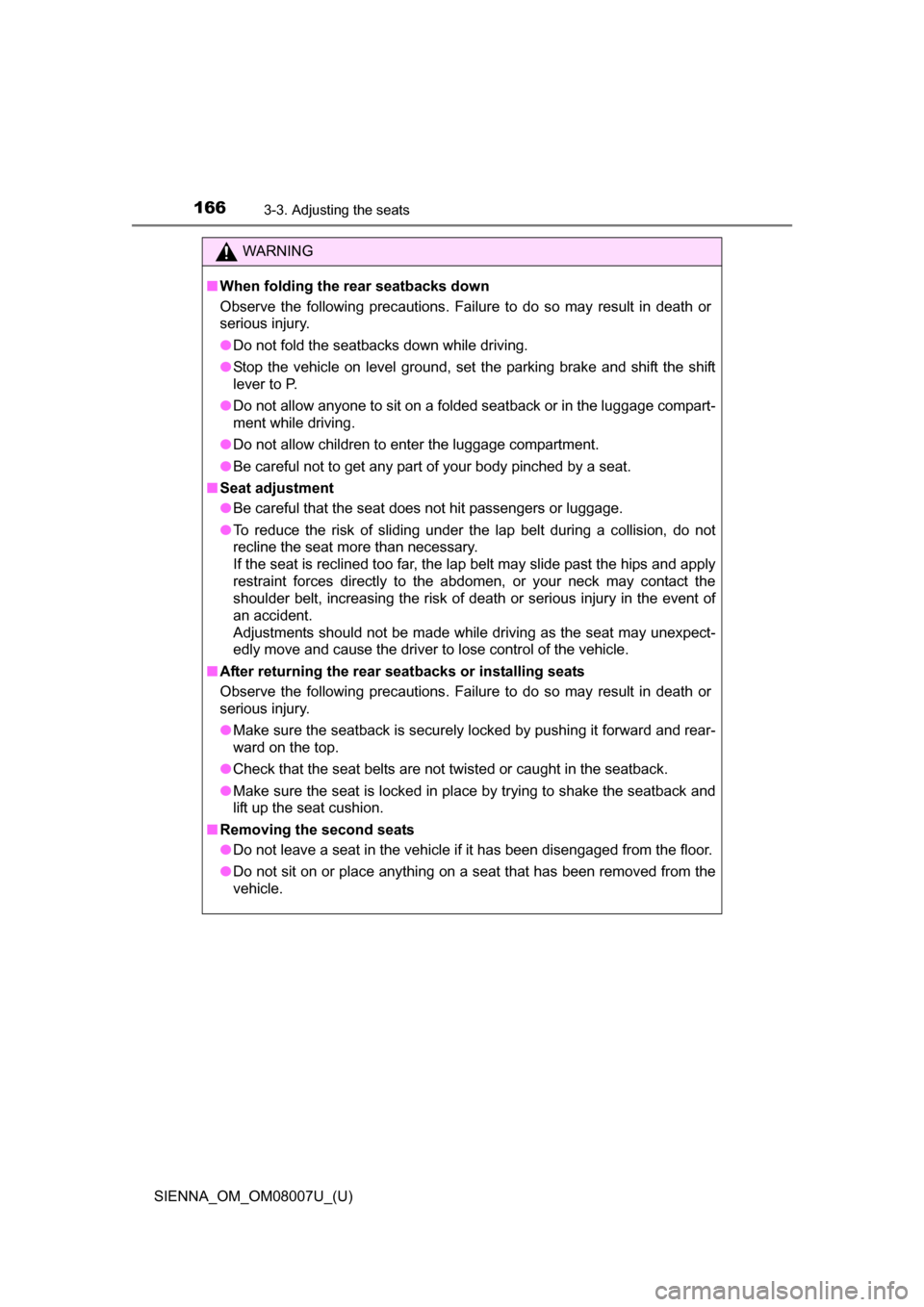
166
SIENNA_OM_OM08007U_(U)
3-3. Adjusting the seats
WARNING
■When folding the rear seatbacks down
Observe the following precautions. Failure to do so may result in death or
serious injury.
●Do not fold the seatbacks down while driving.
● Stop the vehicle on level ground, set the parking brake and shift the shift
lever to P.
● Do not allow anyone to sit on a folded seatback or in the luggage compart-
ment while driving.
● Do not allow children to enter the luggage compartment.
● Be careful not to get any part of your body pinched by a seat.
■ Seat adjustment
●Be careful that the seat does not hit passengers or luggage.
● To reduce the risk of sliding under the lap belt during a collision, do not
recline the seat more than necessary.
If the seat is reclined too far, the lap belt may slide past the hips and apply
restraint forces directly to the abdomen, or your neck may contact the
shoulder belt, increasing the risk of death or serious injury in the event of
an accident.
Adjustments should not be made while driving as the seat may unexpect-
edly move and cause the driver to lose control of the vehicle.
■ After returning the rear seatbacks or installing seats
Observe the following precautions. Failure to do so may result in death or
serious injury.
●Make sure the seatback is securely locked by pushing it forward and rear-
ward on the top.
● Check that the seat belts are not twisted or caught in the seatback.
● Make sure the seat is locked in place by trying to shake the seatback and
lift up the seat cushion.
■ Removing the second seats
●Do not leave a seat in the vehicle if it has been disengaged from the floor.
● Do not sit on or place anything on a seat that has been removed from the
vehicle.
Page 167 of 672
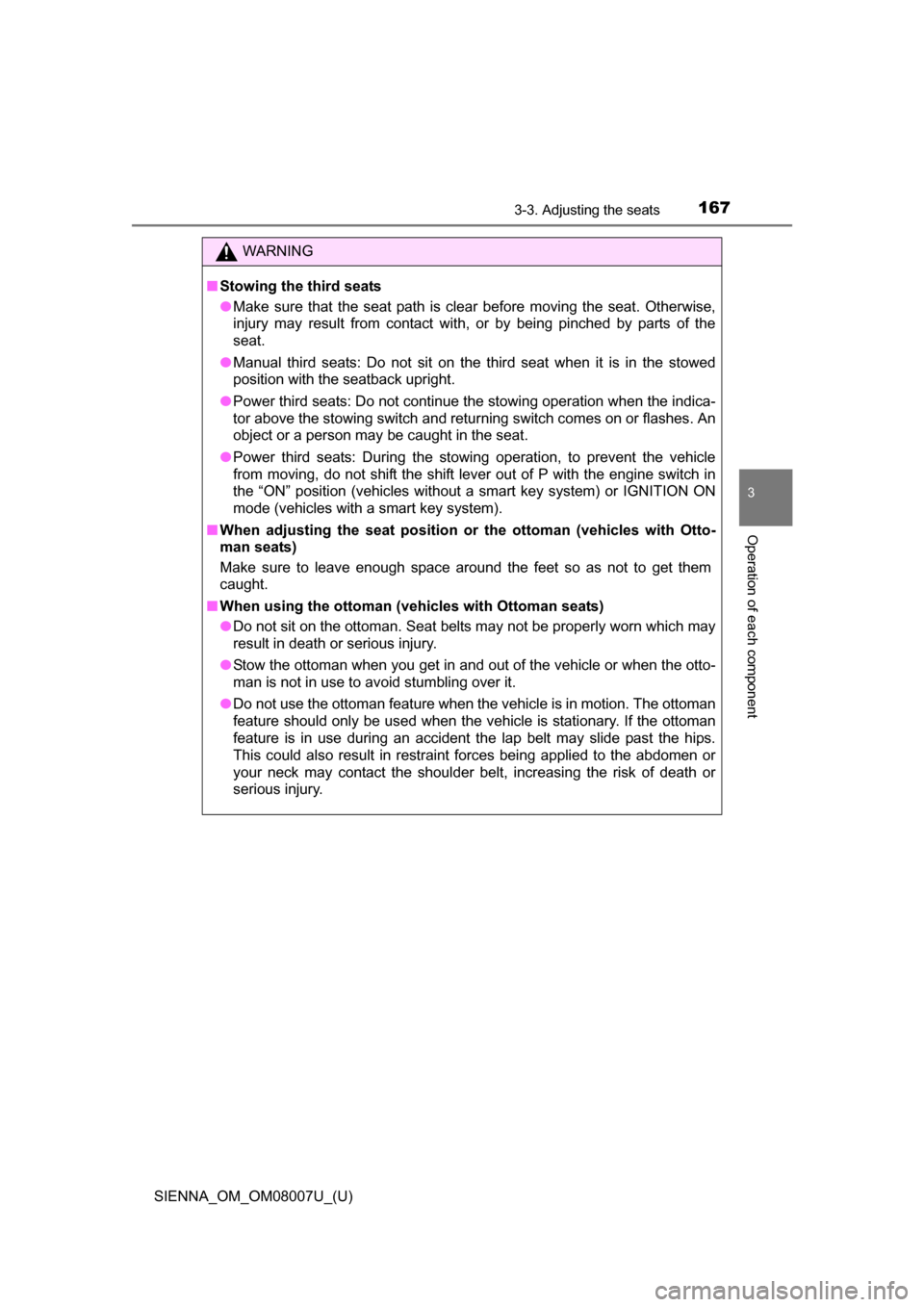
SIENNA_OM_OM08007U_(U)
1673-3. Adjusting the seats
3
Operation of each component
WARNING
■Stowing the third seats
●Make sure that the seat path is clear before moving the seat. Otherwise,
injury may result from contact with, or by being pinched by parts of the
seat.
● Manual third seats: Do not sit on the third seat when it is in the stowed
position with the seatback upright.
● Power third seats: Do not continue the stowing operation when the indica-
tor above the stowing switch and returning switch comes on or flashes. An
object or a person may be caught in the seat.
● Power third seats: During the stowing operation, to prevent the vehicle
from moving, do not shift the shift lever out of P with the engine switch in
the “ON” position (vehicles without a smart key system) or IGNITION ON
mode (vehicles with a smart key system).
■ When adjusting the seat position or the ottoman (vehicles with Otto-
man seats)
Make sure to leave enough space around the feet so as not to get them
caught.
■ When using the ottoman ( vehicles with Ottoman seats)
● Do not sit on the ottoman. Seat belts may not be properly worn which may
result in death or serious injury.
● Stow the ottoman when you get in and out of the vehicle or when the otto-
man is not in use to avoid stumbling over it.
● Do not use the ottoman feature when the vehicle is in motion. The ottoman
feature should only be used when the vehicle is stationary. If the ottoman
feature is in use during an accident the lap belt may slide past the hips.
This could also result in restraint forces being applied to the abdomen or
your neck may contact the shoulder belt, increasing the risk of death or
serious injury.
Page 168 of 672
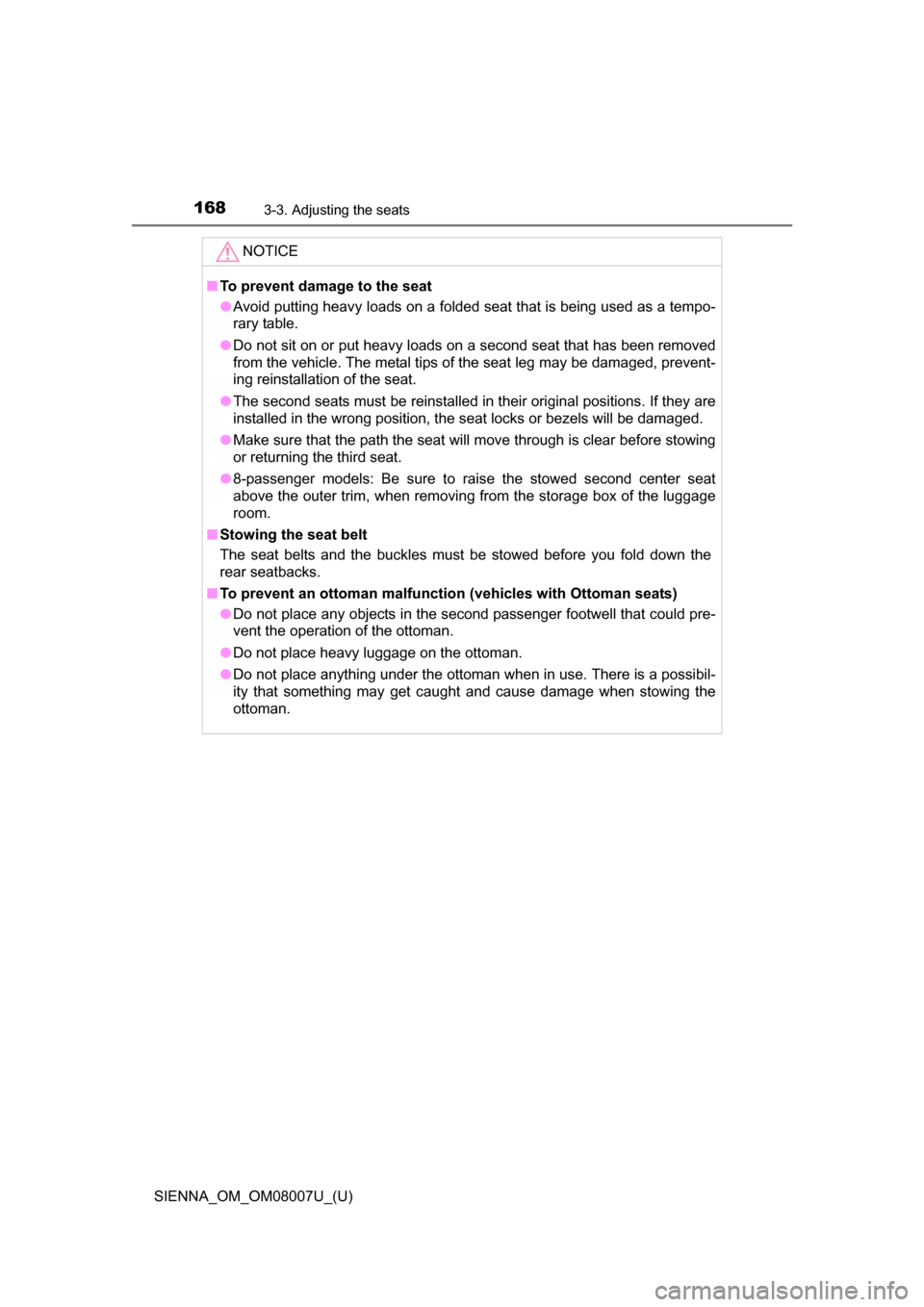
168
SIENNA_OM_OM08007U_(U)
3-3. Adjusting the seats
NOTICE
■To prevent damage to the seat
●Avoid putting heavy loads on a folded seat that is being used as a tempo-
rary table.
● Do not sit on or put heavy loads on a second seat that has been removed
from the vehicle. The metal tips of the seat leg may be damaged, prevent-
ing reinstallation of the seat.
● The second seats must be reinstalled in their original positions. If they are
installed in the wrong position, the seat locks or bezels will be damaged.
● Make sure that the path the seat will move through is clear before stowing
or returning the third seat.
● 8-passenger models: Be sure to raise the stowed second center seat
above the outer trim, when removing from the storage box of the luggage
room.
■ Stowing the seat belt
The seat belts and the buckles must be stowed before you fold down the
rear seatbacks.
■ To prevent an ottoman malfunctio n (vehicles with Ottoman seats)
● Do not place any objects in the second passenger footwell that could pre-
vent the operation of the ottoman.
● Do not place heavy luggage on the ottoman.
● Do not place anything under the ottoman when in use. There is a possibil-
ity that something may get caught and cause damage when stowing the
ottoman.
Page 169 of 672
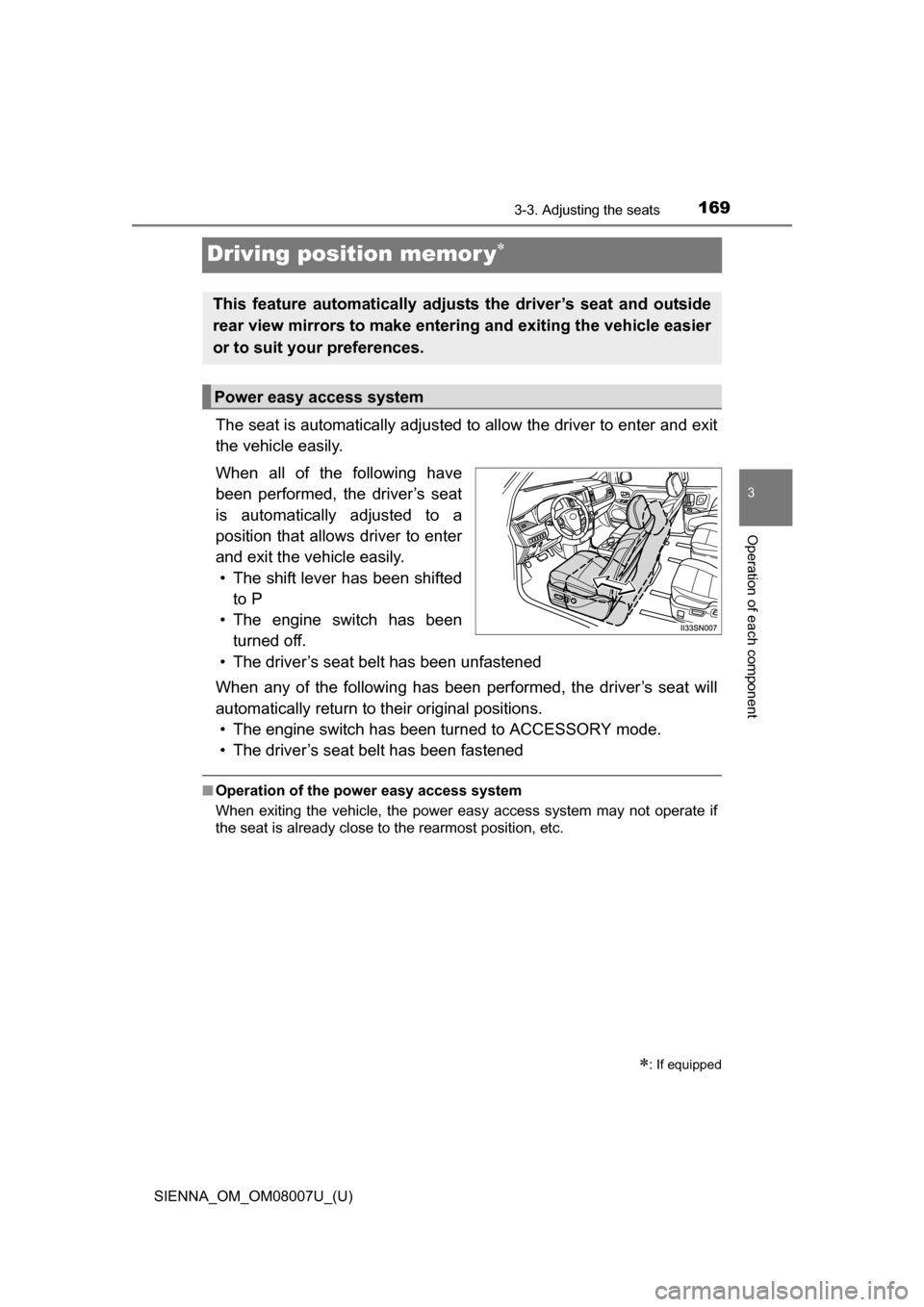
169
SIENNA_OM_OM08007U_(U)
3-3. Adjusting the seats
3
Operation of each component
Driving position memor y
The seat is automatically adjusted to allow the driver to enter and exit
the vehicle easily.
When all of the following have
been performed, the driver’s seat
is automatically adjusted to a
position that allows driver to enter
and exit the vehicle easily.• The shift lever has been shifted to P
• The engine switch has been turned off.
• The driver’s seat belt has been unfastened
When any of the following has been performed, the driver’s seat will
automatically return to their original positions. • The engine switch has been turned to ACCESSORY mode.
• The driver’s seat belt has been fastened
■ Operation of the power easy access system
When exiting the vehicle, the power easy access system may not operate if
the seat is already close to the rearmost position, etc.
: If equipped
This feature automatically adjusts the driver’s seat and outside
rear view mirrors to make entering and exiting the vehicle easier
or to suit your preferences.
Power easy access system
Page 207 of 672
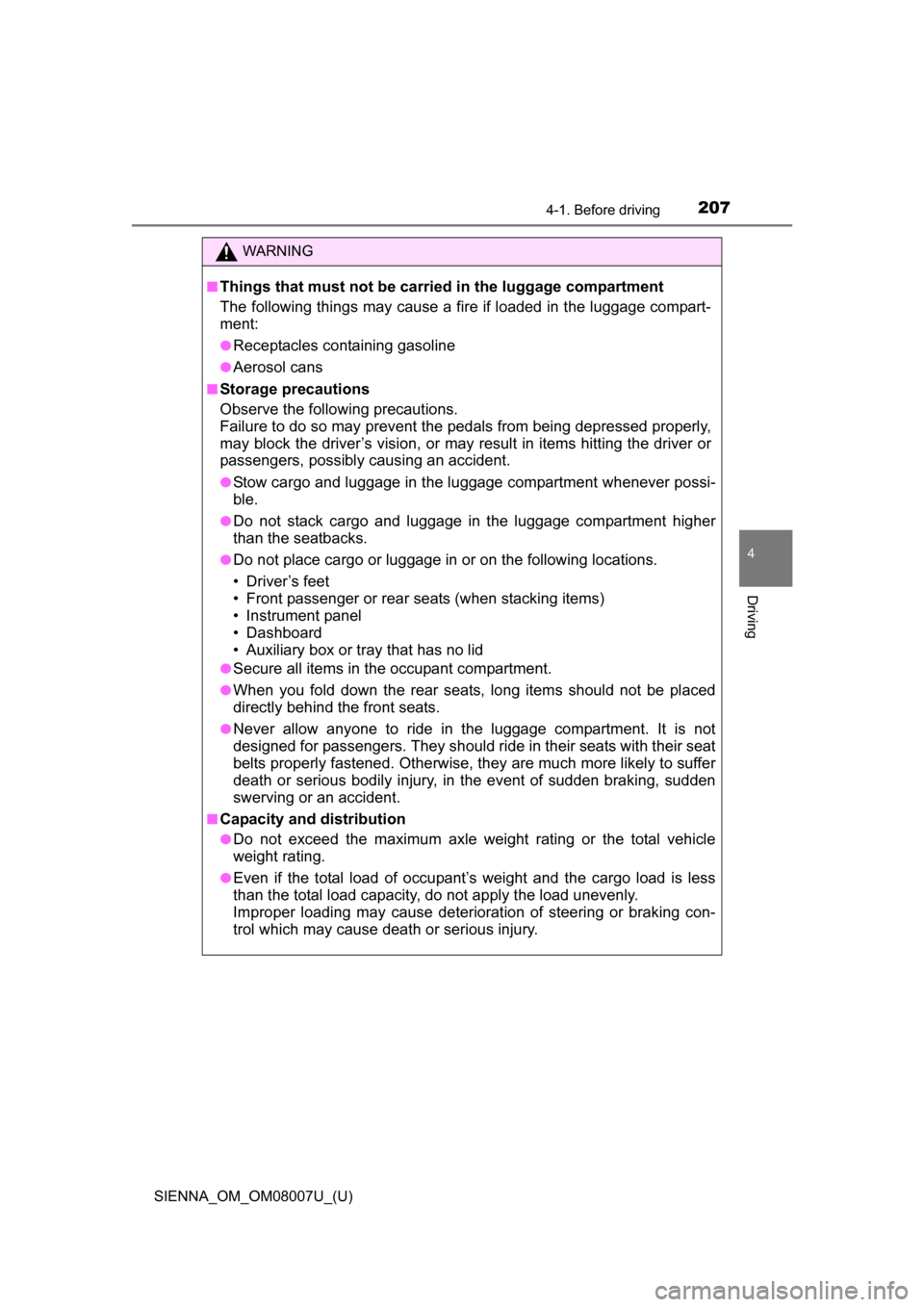
SIENNA_OM_OM08007U_(U)
2074-1. Before driving
4
Driving
WARNING
■Things that must not be carried in the luggage compartment
The following things may cause a fire if loaded in the luggage compart-
ment:
●Receptacles containing gasoline
●Aerosol cans
■Storage precautions
Observe the following precautions.
Failure to do so may prevent the pedals from being depressed properly,
may block the driver’s vision, or may result in items hitting the driver or
passengers, possibly causing an accident.
●Stow cargo and luggage in the luggage compartment whenever possi-
ble.
●Do not stack cargo and luggage in the luggage compartment higher
than the seatbacks.
●Do not place cargo or luggage in or on the following locations.
• Driver’s feet
• Front passenger or rear seats (when stacking items)
• Instrument panel
• Dashboard
• Auxiliary box or tray that has no lid
●Secure all items in the occupant compartment.
●When you fold down the rear seats, long items should not be placed
directly behind the front seats.
●Never allow anyone to ride in the luggage compartment. It is not
designed for passengers. They should ride in their seats with their seat
belts properly fastened. Otherwise, they are much more likely to suffer
death or serious bodily injury, in the event of sudden braking, sudden
swerving or an accident.
■Capacity and distribution
●Do not exceed the maximum axle weight rating or the total vehicle
weight rating.
●Even if the total load of occupant’s weight and the cargo load is less
than the total load capacity, do not apply the load unevenly.
Improper loading may cause deterioration of steering or braking con-
trol which may cause death or serious injury.
Page 302 of 672

302
SIENNA_OM_OM08007U_(U)
4-5. Using the driving support systems
PCS (Pre-Collision System)
◆Pre-collision warning
When a high possibility of a
frontal collision is detected, the
pre-collision system warning
light flashes, a buzzer sounds
and a message is shown on the
multi-information display to
urge the driver to take evasive
action.
◆Pre-collision seat belts (front seat belts only)
If the pre-collision sensor detects that a collision is unavoidable, the
pre-collision system will retract the seat belt before the collision
occurs. The same will happen if the driver makes an emergency
braking or loses control of the vehicle. ( P. 3 1 )
However, when the VSC system is disabled, the system will not
operate in the event of skidding.
◆Pre-collision brake assist
When there is a high po ssibility of a frontal collision, the system
applies greater braking force in relation to how strongly the brake
pedal is depressed.
The system may not warn the driver using a warning light, warning
display and buzzer when the system detects and judges braking
operations.
: If equipped
When the radar sensor detects pos sibility of a frontal collision,
the pre-collision system such as the brakes and seat belts are
automatically engaged to lessen impact as well as vehicle dam-
age.
Page 304 of 672

304
SIENNA_OM_OM08007U_(U)
4-5. Using the driving support systems
■The pre-collision system is operational when
● Pre-collision seat belts (type A):
• The front occupants are wearing a seat belt.
• Vehicle speed is greater than about 19 mph (30 km/h).
• The system detects sudden braking or skidding.
● Pre-collision seat belts (type B):
• The front occupants are wearing a seat belt.
• Vehicle speed is greater than about 4 mph (5 km/h).
• The speed at which your vehicle is approaching the obstacle or the vehi-
cle running ahead of you is greater than about 19 mph (30 km/h).
● Pre-collision braking:
• The pre-collision braking off switch is not pressed.
• Vehicle speed is greater than about 10 mph (15 km/h).
• The speed at which your vehicle is approaching the obstacle or the vehi-
cle running ahead of you is greater than about 10 mph (15 km/h).
● Pre-collision brake assist:
• Vehicle speed is greater than about 19 mph (30 km/h).
• The speed at which your vehicle is approaching the obstacle or the vehi-
cle running ahead of you is greater than about 19 mph (30 km/h).
• The brake pedal is depressed.